Content
Ear primrose (Primula auricula) is a perennial, low-growing herb that blooms in small inflorescences with a mealy bloom on the petals. They are grown mainly in flower beds. There are many varieties of culture, each with an individual appearance and characteristics.

The timing of flowering and the color of primrose buds depends on the variety
Description of ear primrose
"Ear primrose" first appeared in the mountainous belt of southern and central Europe. The plant is dense, oval, with evergreen leaves with a shiny smooth surface and gray dusting. The thick stem grows to a length of about 20 cm, forming an inflorescence at the end with fragrant and bright flowers.
The plant is found in the wild, on the slopes of the Alps, Carpathians, Tatras at an altitude of 2.5 km above sea level. For four hundred years of cultivation, breeders have bred a huge number of varieties, including exotic exhibition specimens and hardy species with simple agricultural technology.
"Ear primrose" has a second name - auricula, popularly called "bear ears". It has gained particular popularity due to its vitality, easy care and the fact that it is one of the first to bloom in the garden.
Types and varieties of ear primrose
"Ear primrose" (auricle) has about 400 species, which are radically different from each other in shape, size, color and type of inflorescences. Divided into blooming in spring and summer. The culture grows in different conditions, in almost all climatic zones, has an enviable cold resistance. Many species can be found in one flower garden. The lifespan of the "Ear primrose" depends on the particular variety. There are those that live only 12 months, but on average, the bushes bloom profusely for 3-4 seasons. Some species bloom in the second year of life.
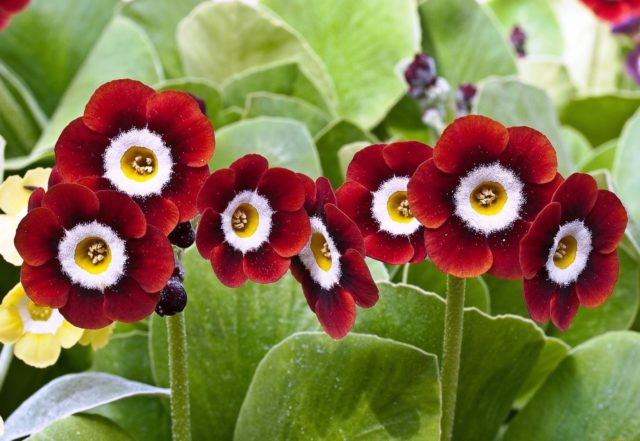
Eared primrose varieties are presented in almost all colors: yellow, red, purple, carmine, burgundy and apricot
Any kind of plant can be easily obtained from seeds, and then planted in a permanent place. The most common is the dwarf species (Primula Dwarf), which grows in the Middle East and East Asia, Western Europe, Crimea and Russia. It has lush inflorescences with numerous flowers in white, yellow, pink, red and purple.
Application in landscape design
Because of the bright color, "Ushkovaya Primula" often becomes a highlight in the landscape design of the garden. In addition, summer residents love the plant because it opens the flower season from the beginning of spring. When creating a composition on a flower bed, a combination of different species looks interesting, they perfectly coexist with other flowering plants: daffodils, crocuses, hyacinths, tulips.
Perennial "Primula ear" is used to frame arbors, alleys and benches. It becomes a decoration of fabulous gardens, multi-tiered flower beds and alpine hills. It is planted with a rhombus, semicircle and rows.
Breeding features
"Ear primrose" propagates by leaf and root cuttings. The process of dividing a plant can be carried out both before and after flowering, as well as during it. But more often it is done in May-June as follows:
- Dig up a whole bush.
- Cleanse it from the ground.
- With the help of scissors, they are divided into "divisions".
- Remove damaged leaves and peduncles from them.
- Cuttings are planted in boxes with loose soil.
- Watering.
- Cover with glass or foil.
- Put in a shady place in the garden.
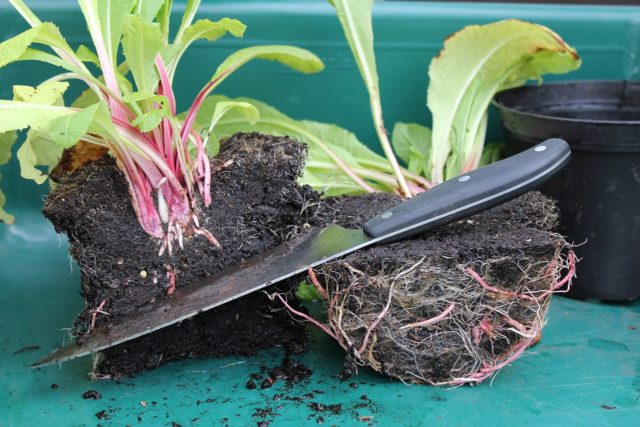
Reproduction is best done by seeds, which are better sown in autumn.
Leaf cuttings are carried out as follows:
- Large leaves of the plant are cut obliquely.
- The cut site is treated with coal.
- Cuttings are planted in containers filled with peat and sand in a 1: 1 ratio.
- They put the boxes in a dark greenhouse.
- They are planted in a permanent place when 2-3 true leaves appear.
Planting and caring for ear primrose
Cultivation of the flower "Ushkovaya primrose" is made from seeds. The process is simple and does not take much time for the grower, but it brings great satisfaction from the result obtained. Primrose is considered an unpretentious plant, but it requires compliance with certain rules for planting and care.
Growing ear primrose from seeds
At home, "Ear primrose" begin to grow in February-March, and even earlier in the presence of artificial lighting. Experienced gardeners germinate primrose seeds in October-November to achieve earlier flowering. If you sow "Ear primrose" in the spring, you can wait for inflorescences only after a year.
In open ground, seeds are sown when the snow melts. But at the same time, they carefully monitor the moisture content of the soil, so that the seedlings are not washed away by rain, they are not damaged by insects and other animals.
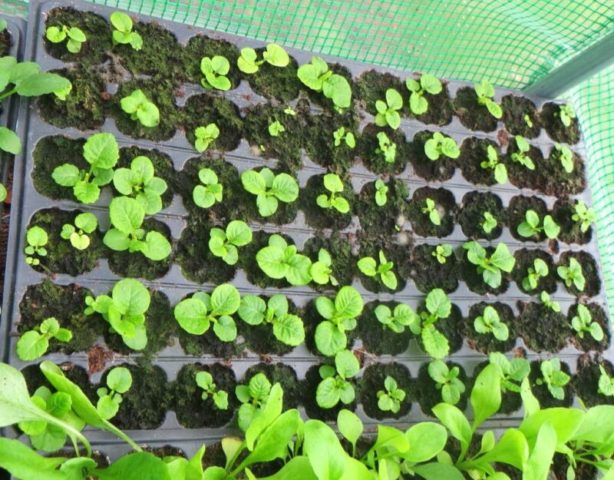
In the presence of illumination, "Primula ear" can be sown in December
Also "Primula ear" can be sown in summer and autumn. In the first case, a lot of seed will be needed, since their survival rate in hot weather is low. In the second case, seeds of varieties requiring stratification are sown. Although experienced gardeners are advised to arrange a temperature swing for all plant seeds. So they will become more resilient and subsequently give amicable and strong shoots.
Sowing "Primula ear" is produced in a substrate consisting of leaf humus, sod land and river sand. Seeds are spread on the surface of the soil and lightly sprinkled with earth. After that, the containers are covered with glass or foil and placed in a warm place. After 5-7 days, the containers are transferred for 3 weeks to a cold loggia, as the earth dries up, watering is carried out. When the sprouts appear on the surface of the earth, the boxes are placed in a room with a temperature of up to 20 0C, the shelter is removed. Seedlings are watered as necessary and darkened from the bright rays of the sun.
A pick "Primula with an ear" is carried out when 4 leaves appear on the plants. They are planted in open ground in early summer.
Transfer to the ground
"Winter" seedlings of "Eared primrose" are recommended to be planted in late April-early May. Seedlings planted in spring are transplanted into the ground closer to September. The plant thrives best in partially shaded, well-ventilated areas, under trees and shrubs. Close occurrence of groundwater is allowed. Does not tolerate direct sunlight.
To the composition of the soil "Primula ear" is very demanding. Prefers nutritious, slightly acidic, moisture-absorbing and breathable soil. Before planting, the beds are dug up with rotted humus, peat, chopped moss and coarse river sand. If the soil is heavy and poorly nutritious, then its top layer (30 cm) is replaced.
The "ear primrose" is planted according to the following algorithm:
- Holes are made at a distance of 15-30 cm.
- Fill them with water.
- Seedlings are placed inside without deepening.
- Sprinkle with earth, lightly tamp and watered.
- Add a layer of mulch.
While caring for the plant, the bushes are regularly and abundantly moisturized, trying not to get into the center of the outlets. The land is loosened, freed from weeds and fertilized.Before flowering, nitrogen fertilizing is applied (bird droppings, mullein), during - phosphorus-potassium mixtures (every two weeks). After the primrose of the ear has faded, the peduncles are removed, the bushes are spudded, they overstep the winter preparation. Perennial species are planted every few years.
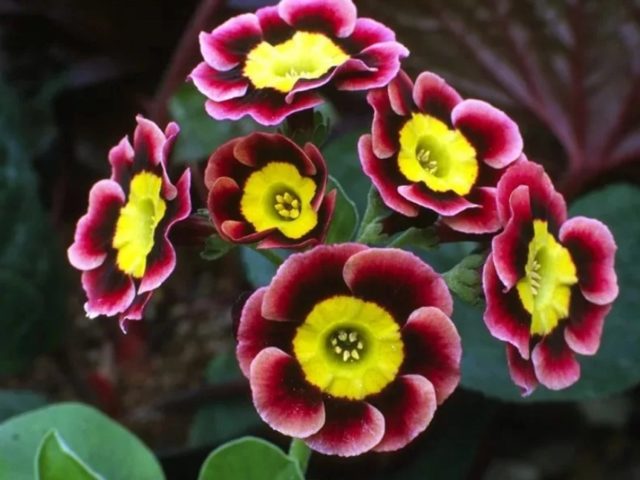
Subject to agricultural technology, the flowering of ear primrose can be used to decorate individual flower beds
Wintering
To organize the wintering of the "Primula ear" flower, it is necessary to strictly follow the sequence of preparation stages. It is carried out according to the following scheme:
- After the end of flowering, the site is cleaned.
- Towards winter, they make abundant watering and aeration of the soil (they loosen the holes around the plant).
- With the arrival of stable frosts, they bring humus under the bushes, and sprinkle with a layer of earth.
- During a cold snap to -10 °They cover the plant with twigs or spruce branches.
Transfer
If "Primula ear" lives for a long time without transplanting, then its flowering declines, the roots begin to bare, it becomes vulnerable to cold weather. Therefore, it is advisable to change the "place of residence" of the plant every 3-4 years. Garden primroses are transplanted when they grow strongly, and domestic primroses - if they become cramped in the pot.
Transplanting time depends on the type of flower. If "Primula ear" has two phases of growth, it is transplanted after the end of budding in autumn or spring. With a single flowering, the transplant is performed in early autumn.
The root system of the "Primula Ushkovaya" is fragile, so the procedure is performed very carefully. First, a bush is dug up and the roots are washed, then the plant is divided into 2-3 parts, the cuts are treated with crushed coal and transplanted to a new place.
A couple of months after the transplant, it is advisable to feed the primrose. For this purpose, natural fertilizers are better suited, for example, chicken manure diluted in a ratio of 1:15.
Diseases and pests
"Ear primrose" practically has no health problems, but with improper care, the gardener may face a number of diseases:
- stem and root collar rot;
- powdery mildew;
- rust;
- bacterial spotting.
Much harm to the "Ear primrose" is caused by infection with the fungus Ramularia cercosporella, which appears in the form of gray or brown spots on the leaves. If a problem is found, it is necessary to cut off the damaged parts of the plant and treat with an antifungal solution.
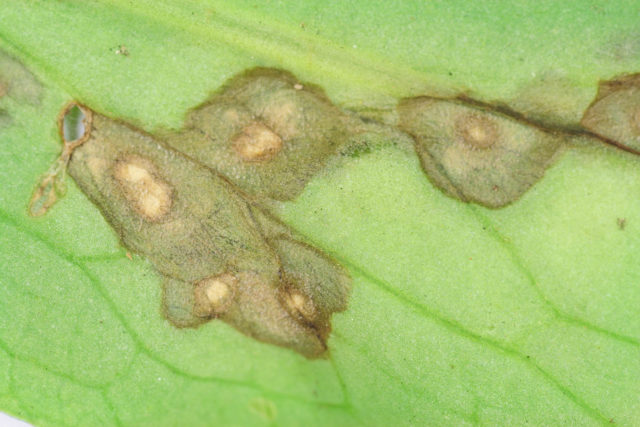
If ramularia is detected, all damaged leaves must be removed.
Garden pests should be wary of fleas, slugs, snails, spider mites and aphids.
Severe damage, and even the death of the "Ear primrose", can occur due to the invasion of the beetle weevil furrowed weevil. Its larvae live in the roots of the plant and weaken them, and the insect itself feeds on the aboveground part of the culture and its leaves.
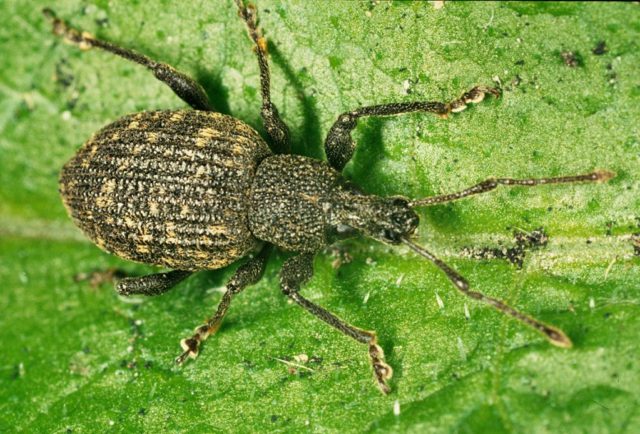
Weevils on primrose flowers are sprayed with insecticides
Conclusion
The ear primrose will be a wonderful decoration for a personal plot, terrace or balcony. With proper care, it has been pleasing gardeners with wonderful flowers for several years. And when combining species with different flowering periods, the plant can be admired from early spring to late summer.








